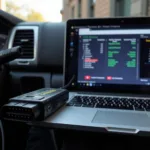OBD2 protocols are the backbone of vehicle diagnostics. They dictate how your OBD2 scanner communicates with your car’s computer, retrieving valuable information about its health and performance. Whether you’re a seasoned mechanic or a car enthusiast, understanding these protocols is crucial for effective vehicle troubleshooting and maintenance.
The Language of Your Car: What are OBD2 Protocols?
Imagine trying to have a conversation with someone who speaks a completely different language. That’s essentially what you’re doing when you connect an OBD2 scanner without understanding the communication protocols.
OBD2 protocols are standardized sets of rules and commands that dictate how your scanner interacts with your vehicle’s Engine Control Unit (ECU). Just like different languages have unique grammar and vocabulary, each OBD2 protocol uses specific commands and data structures for communication.
Why are there multiple protocols? As vehicles evolved, so did their diagnostic systems. Different manufacturers and geographical regions adopted different standards, leading to the variety of protocols we see today.
Navigating the Protocol Maze: Common Types and Their Significance
Here’s a closer look at some of the most common OBD2 protocols:
- SAE J1850 PWM (Pulse Width Modulation): Primarily used in older Ford vehicles.
- SAE J1850 VPW (Variable Pulse Width): Commonly found in GM vehicles manufactured before 2004.
- ISO 9141-2: Frequently used in European and Asian vehicles, especially older models.
- ISO 14230-4 (KWP2000): A predecessor to CAN bus, found in various European and Asian cars.
- ISO 15765-4 (CAN bus): The most prevalent protocol today, used in most modern vehicles globally.
Why Does Knowing the Right Protocol Matter?
Using the correct protocol is essential for a few key reasons:
- Successful Communication: Selecting the wrong protocol is like trying to fit a square peg in a round hole – your scanner simply won’t be able to communicate with your car’s ECU.
- Accurate Data Retrieval: Each protocol has a unique way of formatting and transmitting data. Using the incorrect one can lead to garbled or inaccurate readings.
- Preventing Damage: In some cases, attempting to communicate with the wrong protocol can potentially harm your vehicle’s ECU.
Identifying Your Vehicle’s Protocol: Where to Look
Figuring out your vehicle’s protocol is simpler than you might think. Here are a few reliable methods:
- Check Your Owner’s Manual: The most straightforward approach is to consult your vehicle’s owner’s manual. It usually contains information about the OBD2 protocol used.
- Look for a Sticker Under the Hood: Many vehicles have an emissions sticker located under the hood that specifies the OBD2 protocols in use.
- Use an OBD2 Scanner: Most modern OBD2 scanners can automatically detect the vehicle’s protocol, streamlining the diagnostic process.
Conclusion: Speak Your Car’s Language with Confidence
Understanding OBD2 protocols empowers you to take control of your vehicle’s diagnostics. By knowing the specific protocol your car uses, you can choose the right OBD2 scanner, retrieve accurate data, and confidently diagnose and address any issues that arise. OBDFree is your trusted resource for navigating the world of OBD2.


